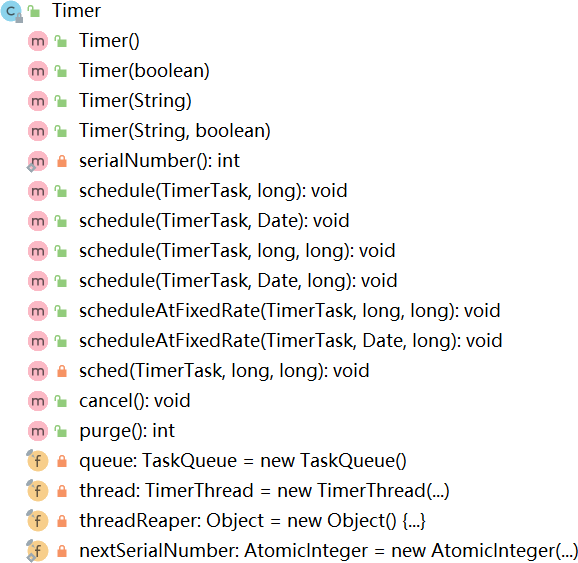中介者模式在JDK源码中的应用
本节主要介绍中介者模式在 JDK 源码中的应用。
打开 JDK 中的 Timer 类,查看 Timer 类的结构,会发现 Timer 类中有很多 schedule() 重载方法,如下图所示。

任意点开其中一个方法,会发现所有方法最终都调用了私有的 sched() 方法,源码如下。
打开 JDK 中的 Timer 类,查看 Timer 类的结构,会发现 Timer 类中有很多 schedule() 重载方法,如下图所示。

任意点开其中一个方法,会发现所有方法最终都调用了私有的 sched() 方法,源码如下。
public class Timer {
...
public void schedule(TimerTask task, long delay) {
if (delay < 0)
throw new IllegalArgumentException("Negative delay.");
sched(task, System.currentTimeMillis()+delay, 0);
}
...
private void sched(TimerTask task, long time, long period) {
if (time < 0)
throw new IllegalArgumentException("Illegal execution time.");
// Constrain value of period sufficiently to prevent numeric
// overflow while still being effectively infinitely large.
if (Math.abs(period) > (Long.MAX_VALUE >> 1))
period >>= 1;
synchronized(queue) {
if (!thread.newTasksMayBeScheduled)
throw new IllegalStateException("Timer already cancelled.");
synchronized(task.lock) {
if (task.state != TimerTask.VIRGIN)
throw new IllegalStateException(
"Task already scheduled or cancelled");
task.nextExecutionTime = time;
task.period = period;
task.state = TimerTask.SCHEDULED;
}
queue.add(task);
if (queue.getMin() == task)
queue.notify();
}
}
...
}
不论是什么样的任务加入到队列中,我们都把这个队列中的对象称为“同事”。查看 sched() 方法的源码可以看出,所有的任务(task)都放到了 Timer 类维护的 task 队列中,同事之间的通信都是通过 Timer 来协调完成的,所以,Timer 承担了中介者的角色,而 task 队列内的任务就是具体同事对象。所有教程
- C语言入门
- C语言编译器
- C语言项目案例
- 数据结构
- C++
- STL
- C++11
- socket
- GCC
- GDB
- Makefile
- OpenCV
- Qt教程
- Unity 3D
- UE4
- 游戏引擎
- Python
- Python并发编程
- TensorFlow
- Django
- NumPy
- Linux
- Shell
- Java教程
- 设计模式
- Java Swing
- Servlet
- JSP教程
- Struts2
- Maven
- Spring
- Spring MVC
- Spring Boot
- Spring Cloud
- Hibernate
- Mybatis
- MySQL教程
- MySQL函数
- NoSQL
- Redis
- MongoDB
- HBase
- Go语言
- C#
- MATLAB
- JavaScript
- Bootstrap
- HTML
- CSS教程
- PHP
- 汇编语言
- TCP/IP
- vi命令
- Android教程
- 区块链
- Docker
- 大数据
- 云计算